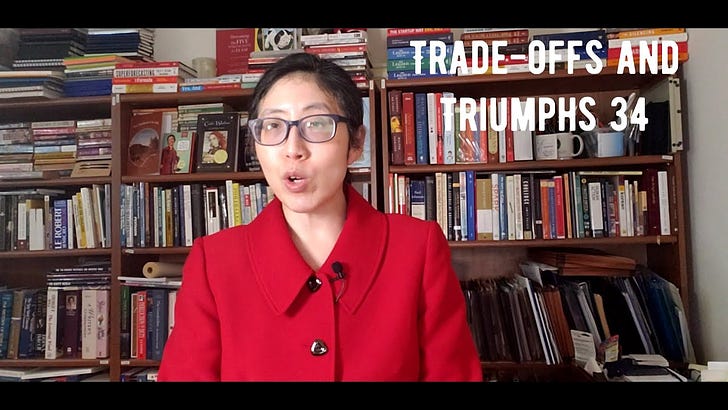Trade-offs and Triumphs 34 by @jennykim
Issue 34: The Lessons of Amelia Bedelia: Concreteness vs Ambiguity in Communication; Resources for the Week; Closing Thoughts
👋 Hello, friends! Thank you for subscribing! Thank you for reading!
Welcome to issue 34 of Trade-offs and Triumphs - a newsletter of resources and thoughts about how to balance trade-offs in life to find and celebrate the small triumph; every decision point requires thinking through trade-offs and not just immediately aiming for the “solution.”
How was your week? What were your trade-offs and triumphs?
This week we will hit on:
👉 The Lessons of Amelia Bedelia: Concreteness vs Ambiguity in Communication
👉 Resources for the Week
👉 Closing Thoughts: The Power of a Conversation, Following Your Heart, A Visual of 2020, and Art Deco in Chicago
For a quick oral summary of Issue 34, hit ▶️ below:
🎪🎶📣📯 The Lessons of Amelia Bedelia: Concreteness vs Ambiguity in Communication
Are you in an alternate universe or are they?
Have you ever left a meeting thinking that everyone had agreed to the same objectives and action items, only to realize two weeks later that you were on different planets? That you interpreted the same words differently?
This is what I call an “Amelia Bedelia” moment. Amelia Bedelia is a series of children’s books where the main character, Amelia Bedelia, is an irrepressible and lovable housekeeper, who tends to take her instructions literally.
For example, when Amelia Bedelia receives instructions to “change the towels in the green bathroom,” she takes some scissors and snips “a little here and a little there” to change the towels. But another person may have interpreted this to mean that these original towels needed to be exchanged for newly laundered towels.
Whether meetings, customer service, or personal relationships, how do we improve communication? How do we reduce ambiguity, lost time, and frustration?
In his weekly LinkedIn Newsletter, “Leadership and Decision Making,” Xinjin Zhao explains that it may take a “simple shift in language” to improve customer service, because how we use words (pitch, inflection, cadence, and tone) can shape attitudes and behaviors. Xinjin provides examples from Spanish, Korean, Hindi, Japanese, and Chinese languages where the vocabulary and phrases do not provide the entire context. Although direct translation may imply clarity, depending on context, body language, and inflection, you and your counterparty may be interpreting the next step very differently.
As you read Xinjin’s essay, take a moment to reflect on when you experienced your “Amelia Bedelia” moments in the English language. And, then think about how to ensure that your intent is actually understand as the agreed upon intent, instead of assuming other parties understand. This applies to oral and written communication.
And remember, if you are unsure, ASK. Don’t be afraid of asking questions - it is better to seem foolish than to waste everyone else’s time.
I came across a posting from Professor Jonah Berger at Wharton that quantitatively demonstrated that a simple shift in language could help improve customer satisfaction. The paper suggests that linguistic concreteness—the tangibility, specificity, or imaginability of words employees use when speaking to customers—can shape consumer attitudes and behaviors.
This reminds me of the implication of linguistic ambiguity, the opposite of concreteness, in the context of cultural agility. There was a story from BBC last year by a person who was visiting Mexico for the first time. When she asked a local ice-cream street vendor when he expected a new delivery of chocolate ice cream, she was told “ahorita”, which directly translates to “right now”. After waiting for half an hour with no sign of the delivery, she went back and asked again and got the same answer, or almost the same answer, “Ahoriiiiita” with an obvious expression of confusion from the vendor. It turns out that when a Mexican says ‘ahorita’, it can either refer to the present moment, or a vague reference to some point in the future, or never. The stretch in the ‘i’ sound in the word ‘ahorita’ can be a demonstration of the stretching of time. I have to say that sometimes there is something special of the beauty in the ambiguity.
In a different example, Korean language has a unique and versatile phrase ‘우리 [uri],’ which means ‘we/our’ in English. Apparently it is not always as all-inclusive as the English ‘we’—that is, it might not include the listeners, and it might not even be plural, especially when they talk about their family or country. Scholars believe the language use style is a reflection of the Korean culture’s emphasis on the whole rather than the individual.
I just learned from a colleague this week that “kal” in Hindi could mean either yesterday or tomorrow. According to an explanation I found on the internet, “kal” is the word derived from “KAAL”. Kaal is the time taken from the time of sunrise to sunrise in India. As such kal can be the time from today's sunrise to yesterday's or tomorrows sunrise. The exact meaning in a sentence would all be dependent on the context.
While English language is very logical, Japanese language is highly contextual. This means that there is an emphasis on implicit, indirect and ambiguous communication. For example, “Yes” in Japanese, “hai,” is often ambiguous depending on the situation. It is used in much the same way an English speaker say “I see” without actually agreeing or disagreeing what you just said. It’s always good to double-check with someone if you think they have a question mark on their face.
Likewise, there are many ambiguous expressions in Chinese which are prone to misinterpretation. For example, a phrase you hear often in business meetings is “Let’s talk about it later.” It could mean “let’s discuss later, possibly privately” but also could mean “I am hoping we’ll both forget and it never comes up again.” It’s up to you to figure out the true intent based on the context or the body language.
With today’s global business environment, it is not only important to have the linguistic concreteness to ensure clarity, but more importantly have the awareness of different cultural context of the people you work with. This is especially true when you have team members who work around the world and many may have anxiety about communicating in English outside of the specific business or technical context, even if they seem to speak English fluently. Even in the same culture, people with different background or in different professions may interpret the same English word very differently.
Going back to the customer satisfaction study, I wonder how the results would have looked in a different culture? Would every culture prefer the concreteness of the answers for customer service or would it be better off with some intentional ambiguity in certain culture? I would love to hear your experience.
✨How can you reduce ambiguity in your oral and written communications?
✨How can you better pay attention to context, body language, and inflection to better ensure that you understand the intent of the communication?
✊⚒️️🧰 Resources for the Week
✅ 1,700 Free Online Courses from Top Universities via Open Culture


✅ Film Your First Video Workshop: Last fall, I participated in Minimum Viable Video led by Cam Houser and Julia Saxena. That course is why you can watch a video summary of this newsletter. You won’t regret attending and trying something new that will advance your life.
📆 Mar 23, 2021 (Tue)
🕐 12:00 PM - 1:00 PM EDT
🎟️ Registration: https://lu.ma/7en9btoc



✅ #NegotiationTribe Q&A with Mark Raffan led by Allan Tsang and Dan Oblinger: Negotiation is about building agreements, moving both parties forward, realizing mutual benefits, and furthering mission and purpose.
The ultimate aim is peace, not winning.
📆 April 2, 2021 (Fri)
🕐 12:00 PM - 1:00 PM EDT
🎟️ Registration: FREE - https://www.88owls.com/free-negotiation-qanda
Closing Thoughts: The Power of a Conversation, Following Your Heart, A Visual of 2020, and Art Deco in Chicago


An Art Deco Mansion in Chicago via WSJ Real Estate - art in the middle of the city


Please leave me your questions or thoughts in the Comments section below 👇👇👇
You can also:
Follow me on Twitter or DM me there,
Email me at jennykimwop@gmail.com.
If you are enjoying Trade-offs and Triumphs, I would love it if you shared it with a friend or two by forwarding it or sharing it with the button below!
Be conscious of your trade-offs. Before settling on any one “solution,” run your fingers through all the trade-offs and decide intentionally and specifically.
And then celebrate your triumphs, no matter how small.







